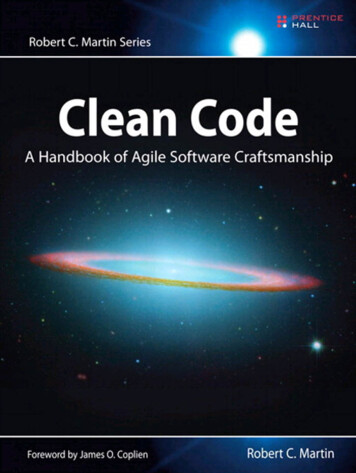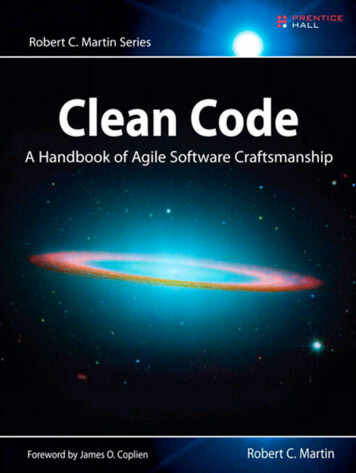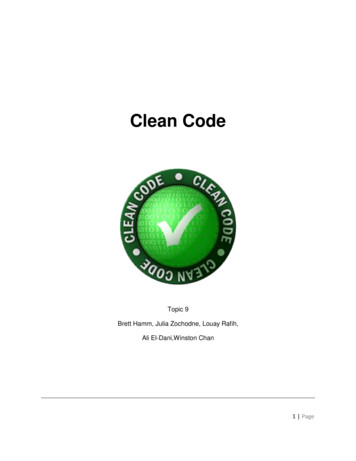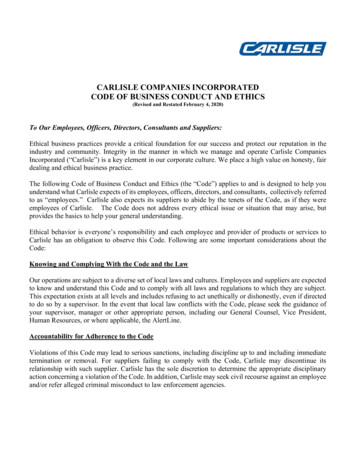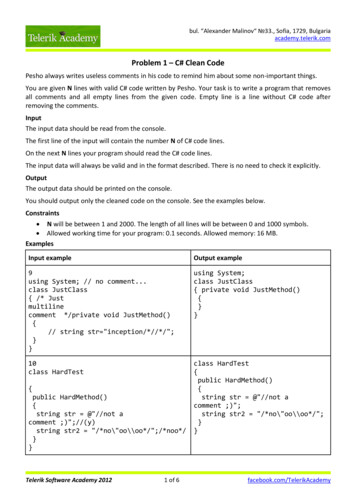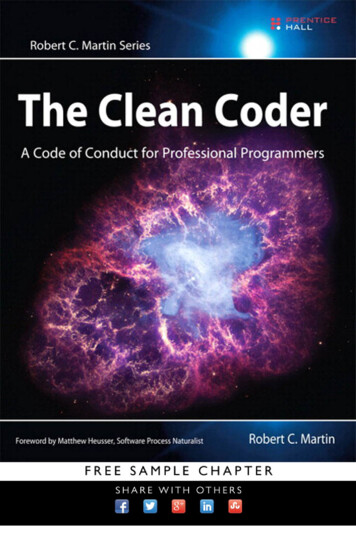
Transcription
Praise for The Clean Coder“‘Uncle Bob’ Martin definitely raises the bar with his latest book. He explains hisexpectation for a professional programmer on management interactions, timemanagement, pressure, on collaboration, and on the choice of tools to use. BeyondTDD and ATDD, Martin explains what every programmer who considers him- orherself a professional not only needs to know, but also needs to follow in order tomake the young profession of software development grow.”—Markus GärtnerSenior Software Developerit-agile GmbHwww.it-agile.dewww.shino.de“Some technical books inspire and teach; some delight and amuse. Rarely does atechnical book do all four of these things. Robert Martin’s always have for me andThe Clean Coder is no exception. Read, learn, and live the lessons in this book andyou can accurately call yourself a software professional.”—George BullockSenior Program ManagerMicrosoft Corp.“If a computer science degree had ‘required reading for after you graduate,’ thiswould be it. In the real world, your bad code doesn’t vanish when the semester’sover, you don’t get an A for marathon coding the night before an assignment’s due,and, worst of all, you have to deal with people. So, coding gurus are not necessarilyprofessionals. The Clean Coder describes the journey to professionalism . . . and itdoes a remarkably entertaining job of it.”—Jeff OverbeyUniversity of Illinois at Urbana-Champaign“The Clean Coder is much more than a set of rules or guidelines. It contains hardearned wisdom and knowledge that is normally obtained through many years oftrial and error or by working as an apprentice to a master craftsman. If you callyourself a software professional, you need this book.”—R. L. BogettiLead System DesignerBaxter Healthcarewww.RLBogetti.com
This page intentionally left blank
The Clean Coder
The Robert C. Martin SeriesVisit informit.com/martinseries for a complete list of available publications.The Robert C. Martin Series is directed at software developers, teamleaders, business analysts, and managers who want to increase theirskills and proficiency to the level of a Master Craftsman. The series containsbooks that guide software professionals in the principles, patterns, andpractices of programming, software project management, requirementsgathering, design, analysis, testing and others.
The Clean CoderA C ODE OF C ONDUCT FORP ROFESSIONAL P ROGR AMMERSRobert C. MartinUpper Saddle River, NJ Boston Indianapolis San FranciscoNew York Toronto Montreal London Munich Paris MadridCapetown Sydney Tokyo Singapore Mexico City
Many of the designations used by manufacturers and sellers to distinguish their products are claimed astrademarks. Where those designations appear in this book, and the publisher was aware of a trademarkclaim, the designations have been printed with initial capital letters or in all capitals.The author and publisher have taken care in the preparation of this book, but make no expressed orimplied warranty of any kind and assume no responsibility for errors or omissions. No liability is assumedfor incidental or consequential damages in connection with or arising out of the use of the information orprograms contained herein.The publisher offers excellent discounts on this book when ordered in quantity for bulk purchases orspecial sales, which may include electronic versions and/or custom covers and content particular to yourbusiness, training goals, marketing focus, and branding interests. For more information, please contact:U.S. Corporate and Government Sales(800) 382-3419corpsales@pearsontechgroup.comFor sales outside the United States please contact:International Salesinternational@pearson.comVisit us on the Web: www.informit.com/phLibrary of Congress Cataloging-in-Publication DataMartin, Robert C.The clean coder : a code of conduct for professional programmers / Robert Martin.p. cm.Includes bibliographical references and index.ISBN 0-13-708107-3 (pbk. : alk. paper)1. Computer programming—Moral and ethical aspects. 2. Computerprogrammers—Professional ethics. I. Title.QA76.9.M65M367 2011005.1092—dc222011005962Copyright 2011 Pearson Education, Inc.All rights reserved. Printed in the United States of America. This publication is protected by copyright, andpermission must be obtained from the publisher prior to any prohibited reproduction, storage in a retrievalsystem, or transmission in any form or by any means, electronic, mechanical, photocopying, recording, orlikewise. For information regarding permissions, write to:Pearson Education, Inc.Rights and Contracts Department501 Boylston Street, Suite 900Boston, MA 02116Fax: (617) 671-3447ISBN-13: 978-0-13-708107-3ISBN-10:0-13-708107-3Text printed in the United States on recycled paper at RR Donnelley in Crawfordsville, Indiana.First printing, May 2011
Between 1986 and 2000 I worked closely with Jim Newkirk, a colleague fromTeradyne. He and I shared a passion for programming and for clean code.We would spend nights, evenings, and weekends together playing with differentprogramming styles and design techniques. We were continually schemingabout business ideas. Eventually we formed Object Mentor, Inc., together.I learned many things from Jim as we plied our schemes together. But one ofthe most important was his attitude of work ethic; it was something I strove toemulate. Jim is a professional. I am proud to have worked with him, and to callhim my friend.
This page intentionally left blank
CONTENTSForewordPrefaceAcknowledgmentsAbout the AuthorOn the CoverxiiixixxxiiixxixxxxiPre-Requisite Introduction1Chapter 17Chapter 2ProfessionalismBe Careful What You Ask ForTaking ResponsibilityFirst, Do No HarmWork EthicBibliography88111622Saying No23Adversarial RolesHigh StakesBeing a “Team Player”The Cost of Saying YesCode Impossible2629303641ix
C ONTENTSChapter 3Chapter 4Chapter 5Chapter 6Chapter 7Chapter 8xSaying Yes45A Language of CommitmentLearning How to Say “Yes”Conclusion475256Coding57PreparednessThe Flow ZoneWriter’s BlockDebuggingPacing YourselfBeing LateHelpBibliography5862646669717376Test Driven Development77The Jury Is InThe Three Laws of TDDWhat TDD Is NotBibliography79798384Practicing85Some Background on PracticingThe Coding DojoBroadening Your ce Testing95Communicating RequirementsAcceptance TestsConclusion95100111Testing Strategies113QA Should Find Nothing114
C ONTENTSChapter 9Chapter 10Chapter 11Chapter 12Chapter 13The Test Automation PyramidConclusionBibliography115119119Time Management121MeetingsFocus-MannaTime Boxing and TomatoesAvoidanceBlind AlleysMarshes, Bogs, Swamps, and Other What Is an Estimate?PERTEstimating TasksThe Law of Large ssure149Avoiding PressureHandling mers versus PeopleCerebellumsConclusion159164166Teams and Projects167Does It Blend?ConclusionBibliography168171171xi
C ONTENTSChapter 14Appendix AIndexxiiMentoring, Apprenticeship, and Craftsmanship173Degrees of ion174174180184185Tooling187ToolsSource Code ControlIDE/EditorIssue TrackingContinuous BuildUnit Testing ToolsComponent Testing ToolsIntegration Testing 04205
FO R E WO R DYou’ve picked up this book, so I assume you are a software professional. That’sgood; so am I. And since I have your attention, let me tell you why I picked upthis book.It all starts a short time ago in a place not too far away. Cue the curtain, lightsand camera, Charley .Several years ago I was working at a medium-sized corporation selling highlyregulated products. You know the type; we sat in a cubicle farm in a three-storybuilding, directors and up had private offices, and getting everyone you neededinto the same room for a meeting took a week or so.We were operating in a very competitive market when the government openedup a new product.Suddenly we had an entirely new set of potential customers; all we had to dowas to get them to buy our product. That meant we had to file by a certaindeadline with the federal government, pass an assessment audit by another date,and go to market on a third date.xiii
F OREWORDOver and over again our management stressed to us the importance of thosedates. A single slip and the government would keep us out of the market for ayear, and if customers couldn’t sign up on day one, then they would all sign upwith someone else and we’d be out of business.It was the sort of environment in which some people complain, and otherspoint out that “pressure makes diamonds.”I was a technical project manager, promoted from development. My responsibilitywas to get the web site up on go-live day, so potential customers could downloadinformation and, most importantly, enrollment forms. My partner in the endeavorwas the business-facing project manager, whom I’ll call Joe. Joe’s role was to workthe other side, dealing with sales, marketing, and the non-technical requirements.He was also the guy fond of the “pressure makes diamonds” comment.If you’ve done much work in corporate America, you’ve probably seen thefinger-pointing, blamestorming, and work aversion that is completely natural.Our company had an interesting solution to that problem with Joe and me.A little bit like Batman and Robin, it was our job to get things done. I met withthe technical team every day in a corner; we’d rebuild the schedule every singleday, figure out the critical path, then remove every possible obstacle from thatcritical path. If someone needed software; we’d go get it. If they would “love to”configure the firewall but “gosh, it’s time for my lunch break,” we would buythem lunch. If someone wanted to work on our configuration ticket but hadother priorities, Joe and I would go talk to the supervisor.Then the manager.Then the director.We got things done.It’s a bit of an exaggeration to say that we kicked over chairs, yelled, andscreamed, but we did use every single technique in our bag to get things done,invented a few new ones along the way, and we did it in an ethical way that I amproud of to this day.xiv
F OREWORDI thought of myself as a member of the team, not above jumping in to write aSQL statement or doing a little pairing to get the code out the door. At the time,I thought of Joe the same way, as a member of the team, not above it.Eventually I came to realize that Joe did not share that opinion. That was a verysad day for me.It was Friday at 1:00 pm; the web site was set to go live very early the followingMonday.We were done. *DONE*. Every system was go; we were ready. I had the entiretech team assembled for the final scrum meeting and we were ready to flip theswitch. More than “just” the technical team, we had the business folks frommarketing, the product owners, with us.We were proud. It was a good moment.Then Joe dropped by.He said something like, “Bad news. Legal doesn’t have the enrollment formsready, so we can’t go live yet.”This was no big deal; we’d been held up by one thing or another for the lengthof the entire project and had the Batman/Robin routine down pat. I was ready,and my reply was essentially, “All right partner, let’s do this one more time.Legal is on the third floor, right?”Then things got weird.Instead of agreeing with me, Joe asked, “What are you talking about Matt?”I said, “You know. Our usual song and dance. We’re talking about four PDFfiles, right? That are done; legal just has to approve them? Let’s go hang out intheir cubicles, give them the evil eye, and get this thing done!”Joe did not agree with my assessment, and answered, “We’ll just go live late nextweek. No big deal.”xv
F OREWORDYou can probably guess the rest of the exchange; it sounded something like this:Matt: “But why? They could do this in a couple hours.”Joe:“It might take more than that.”Matt: “But they’ve got all weekend. Plenty of time. Let’s do this!”Joe:“Matt, these are professionals. We can’t just stare them down andinsist they sacrifice their personal lives for our little project.”Matt: (pause) “. . . Joe . . . what do you think we’ve been doing to theengineering team for the past four months?”Joe: “Yes, but these are professionals.”Pause.Breathe.What. Did. Joe. Just. Say?At the time, I thought the technical staff were professionals, in the best sense ofthe word.Thinking back over it again, though, I’m not so sure.Let’s look at that Batman and Robin technique a second time, from a differentperspective. I thought I was exhorting the team to its best performance, but Isuspect Joe was playing a game, with the implicit assumption that the technicalstaff was his opponent. Think about it: Why was it necessary to run around,kicking over chairs and leaning on people?Shouldn’t we have been able to ask the staff when they would be done, get afirm answer, believe the answer we were given, and not be burned by that belief?Certainly, for professionals, we should . . . and, at the same time, we could not.Joe didn’t trust our answers, and felt comfortable micromanaging the techxvi
F OREWORDteam—and at the same time, for some reason, he did trust the legal team andwas not willing to micromanage them.What’s that all about?Somehow, the legal team had demonstrated professionalism in a way thetechnical team had not.Somehow, another group had convinced Joe that they did not need a babysitter,that they were not playing games, and that they needed to be treated as peerswho were respected.No, I don’t think it had anything to do with fancy certificates hanging on wallsor a few extra years of college, although those years of college might haveincluded a fair bit of implicit social training on how to behave.Ever since that day, those long years ago, I’ve wondered how the technicalprofession would have to change in order to be regarded as professionals.Oh, I have a few ideas. I’ve blogged a bit, read a lot, managed to improve myown work life situation and help a few others. Yet I knew of no book that laidout a plan, that made the whole thing explicit.Then one day, out of the blue, I got an offer to review an early draft of a book;the book that you are holding in your hands right now.This book will tell step by step exactly how to present yourself and interact as aprofessional. Not with trite cliché, not with appeals to pieces of paper, but whatyou can do and how to do it.In some cases, the examples are word for word.Some of those examples have replies, counter-replies, clarifications, even advicefor what to do if the other person tries to “just ignore you.”xvii
F OREWORDHey, look at that, here comes Joe again, stage left this time:Oh, here we are, back at BigCo, with Joe and me, once more on the big web siteconversion project.Only this time, imagine it just a little bit differently.Instead of shirking from commitments, the technical staff actually makes them.Instead of shirking from estimates or letting someone else do the planning(then complaining about it), the technical team actually self-organizes andmakes real commitments.Now imagine that the staff is actually working together. When the programmersare blocked by operations, they pick up the phone and the sysadmin actuallygets started on the work.When Joe comes by to light a fire to get ticket 14321 worked on, he doesn’t needto; he can see that the DBA is working diligently, not surfing the web. Likewise,the estimates he gets from staff seem downright consistent, and he doesn’t getthe feeling that the project is in priority somewhere between lunch andchecking email. All the tricks and attempts to manipulate the schedule are notmet with, “We’ll try,” but instead, “That’s our commitment; if you want to makeup your own goals, feel free.”After a while, I suspect Joe would start to think of the technical team as, well,professionals. And he’d be right.Those steps to transform your behavior from technician to professional? You’llfind them in the rest of the book.Welcome to the next step in your career; I suspect you are going to like it.—Matthew HeusserSoftware Process Naturalistxviii
P R E FA C EAt 11:39 am EST on January 28, 1986, just 73.124 seconds after launch and at analtitude of 48,000 feet, the Space Shuttle Challenger was torn to smithereens bythe failure of the right-hand solid rocket booster (SRB). Seven brave astronauts,including high school teacher Christa McAuliffe, were lost. The expression onthe face of McAuliffe’s mother as she watched the demise of her daughter ninemiles overhead haunts me to this day.The Challenger broke up because hot exhaust gasses in the failing SRB leakedout from between the segments of its hull, splashing across the body of thexix
P REFACEexternal fuel tank. The bottom of the main liquid hydrogen tank burst, ignitingthe fuel and driving the tank forward to smash into the liquid oxygen tankabove it. At the same time the SRB detached from its aft strut and rotatedaround its forward strut. Its nose punctured the liquid oxygen tank. Theseaberrant force vectors caused the entire craft, moving well above mach 1.5, torotate against the airstream. Aerodynamic forces quickly tore everything toshreds.Between the circular segments of the SRB there were two concentric syntheticrubber O-rings. When the segments were bolted together the O-rings werecompressed, forming a tight seal that the exhaust gasses should not have beenable to penetrate.But on the evening before the launch, the temperature on the launch pad gotdown to 17 F, 23 degrees below the O-rings’ minimum specified temperatureand 33 degrees lower than any previous launch. As a result, the O-rings grewtoo stiff to properly block the hot gasses. Upon ignition of the SRB there was apressure pulse as the hot gasses rapidly accumulated. The segments of thebooster ballooned outward and relaxed the compression on the O-rings. Thestiffness of the O-rings prevented them from keeping the seal tight, so someof the hot gasses leaked through and vaporized the O-rings across 70 degreesof arc.The engineers at Morton Thiokol who designed the SRB had known that therewere problems with the O-rings, and they had reported those problems tomanagers at Morton Thiokol and NASA seven years earlier. Indeed, the O-ringsfrom previous launches had been damaged in similar ways, though not enoughto be catastrophic. The coldest launch had experienced the most damage. Theengineers had designed a repair for the problem, but implementation of thatrepair had been long delayed.The engineers suspected that the O-rings stiffened when cold. They also knewthat temperatures for the Challenger launch were colder than any previouslaunch and well below the red-line. In short, the engineers knew that the riskwas too high. The engineers acted on that knowledge. They wrote memosxx
P REFACEraising giant red flags. They strongly urged Thiokol and NASA managers not tolaunch. In an eleventh-hour meeting held just hours before the launch, thoseengineers presented their best data. They raged, and cajoled, and protested. Butin the end, the managers ignored them.When the time for launch came, some of the engineers refused to watch thebroadcast because they feared an explosion on the pad. But as the Challengerclimbed gracefully into the sky they began to relax. Moments before thedestruction, as they watched the vehicle pass through Mach 1, one of them saidthat they’d “dodged a bullet.”Despite all the protest and memos, and urgings of the engineers, the managersbelieved they knew better. They thought the engineers were overreacting. Theydidn’t trust the engineers’ data or their conclusions. They launched because theywere under immense financial and political pressure. They hoped everythingwould be just fine.These managers were not merely foolish, they were criminal. The lives of sevengood men and women, and the hopes of a generation looking toward spacetravel, were dashed on that cold morning because those managers set their ownfears, hopes, and intuitions above the words of their own experts. They made adecision they had no right to make. They usurped the authority of the peoplewho actually knew: the engineers.But what about the engineers? Certainly the engineers did what they weresupposed to do. They informed their managers and fought hard for theirposition. They went through the appropriate channels and invoked all the rightprotocols. They did what they could, within the system—and still the managersoverrode them. So it would seem that the engineers can walk away withoutblame.But sometimes I wonder whether any of those engineers lay awake at night,haunted by that image of Christa McAuliffe’s mother, and wishing they’d calledDan Rather.xxi
P REFACEA B O U T TH I S B O O KThis book is about software professionalism. It contains a lot of pragmaticadvice in an attempt to answer questions, such as What is a software professional? How does a professional behave? How does a professional deal with conflict, tight schedules, and unreasonablemanagers? When, and how, should a professional say “no”? How does a professional deal with pressure?But hiding within the pragmatic advice in this book you will find an attitudestruggling to break through. It is an attitude of honesty, of honor, of selfrespect, and of pride. It is a willingness to accept the dire responsibility of beinga craftsman and an engineer. That responsibility includes working well andworking clean. It includes communicating well and estimating faithfully. Itincludes managing your time and facing difficult risk-reward decisions.But that responsibility includes one other thing—one frightening thing. As anengineer, you have a depth of knowledge about your systems and projects thatno managers can possibly have. With that knowledge comes the responsibilityto act.BIBLIOGR APHY[McConnell87]: Malcolm McConnell, Challenger ‘A Major Malfunction’, NewYork, NY: Simon & Schuster, 1987[Wiki-Challenger]: “Space Shuttle Challenger disaster,”http://en.wikipedia.org/wiki/Space Shuttle Challenger disasterxxii
AC K N OW LE DG M E NT SMy career has been a series of collaborations and schemes. Though I’ve hadmany private dreams and aspirations, I always seemed to find someone to sharethem with. In that sense I feel a bit like the Sith, “Always two there are.”The first collaboration that I could consider professional was with JohnMarchese at the age of 13. He and I schemed about building computerstogether. I was the brains and he was the brawn. I showed him where to solder awire and he soldered it. I showed him where to mount a relay and he mountedit. It was a load of fun, and we spent hundreds of hours at it. In fact, we builtquite a few very impressive-looking objects with relays, buttons, lights, evenTeletypes! Of course, none of them actually did anything, but they were veryimpressive and we worked very hard on them. To John: Thank you!In my freshman year of high school I met Tim Conrad in my German class.Tim was smart. When we teamed up to build a computer, he was the brains andI was the brawn. He taught me electronics and gave me my first introduction toa PDP-8. He and I actually built a working electronic 18-bit binary calculatorout of basic components. It could add, subtract, multiply, and divide. It took usa year of weekends and all of spring, summer, and Christmas breaks. We workedfuriously on it. In the end, it worked very nicely. To Tim: Thank you!xxiii
A CKNOWLEDGMENTSTim and I learned how to program computers. This wasn’t easy to do in 1968,but we managed. We got books on PDP-8 assembler, Fortran, Cobol, PL/1,among others. We devoured them. We wrote programs that we had no hope ofexecuting because we did not have access to a computer. But we wrote themanyway for the sheer love of it.Our high school started a computer science curriculum in our sophomore year.They hooked up an ASR-33 Teletype to a 110-baud, dial-up modem. They hadan account on the Univac 1108 time-sharing system at the Illinois Institute ofTechnology. Tim and I immediately became the de facto operators of thatmachine. Nobody else could get near it.The modem was connected by picking up the telephone and dialing thenumber. When you heard the answering modem squeal, you pushed the “orig”button on the Teletype causing the originating modem to emit its own squeal.Then you hung up the phone and the data connection was established.The phone had a lock on the dial. Only the teachers had the key. But that didn’tmatter, because we learned that you could dial a phone (any phone) by tappingout the phone number on the switch hook. I was a drummer, so I had prettygood timing and reflexes. I could dial that modem, with the lock in place, in lessthan 10 seconds.We had two Teletypes in the computer lab. One was the online machine and theother was an offline machine. Both were used by students to write theirprograms. The students would type their programs on the Teletypes with thepaper tape punch engaged. Every keystroke was punched on tape. The studentswrote their programs in IITran, a remarkably powerful interpreted language.Students would leave their paper tapes in a basket near the Teletypes.After school, Tim and I would dial up the computer (by tapping of course),load the tapes into the IITran batch system, and then hang up. At 10 charactersper second, this was not a quick procedure. An hour or so later, we’d call backand get the printouts, again at 10 characters per second. The Teletype did notseparate the students’ listings by ejecting pages. It just printed one after the nextxxiv
A CKNOWLEDGMENTSafter the next, so we cut them apart using scissors, paper-clipped their inputpaper tape to their listing, and put them in the output basket.Tim and I were the masters and gods of that process. Even the teachers left usalone when we were in that room. We were doing their job, and they knew it.They never asked us to do it. They never told us we could. They never gave usthe key to the phone. We just moved in, and they moved out—and they gave usa very long leash. To my Math teachers, Mr. McDermit, Mr. Fogel, and Mr.Robien: Thank you!Then, after all the student homework was done, we would play. We wroteprogram after program to do any number of mad and weird things. We wroteprograms that graphed circles and parabolas in ASCII on a Teletype. We wroterandom walk programs and random word generators. We calculated 50 factorialto the last digit. We spent hours and hours inventing programs to write andthen getting them to work.Two years later, Tim, our compadre Richard Lloyd, and I were hired asprogrammers at ASC Tabulating in Lake Bluff, Illinois. Tim and I were 18 at thetime. We had decided that college was a waste of time and that we should beginour careers immediately. It was here that we met Bill Hohri, Frank Ryder, BigJim Carlin, and John Miller. They gave some youngsters the opportunity tolearn what professional programming was all about. The experience was not allpositive and not all negative. It was certainly educational. To all of them, and toRichard who catalyzed and drove much of that process: Thank you.After quitting and melting down at the age of 20, I did a stint as a lawn mowerrepairman working for my brother-in-law. I was so bad at it that he had to fireme. Thanks, Wes!A year or so later I wound up working at Outboard Marine Corporation. Bythis time I was married and had a baby on the way. They fired me too. Thanks,John, Ralph, and Tom!xxv
A CKNOWLEDGMENTSThen I went to work at Teradyne where I met Russ Ashdown, Ken Finder, BobCopithorne, Chuck Studee, and CK Srithran (now Kris Iyer). Ken was my boss.Chuck and CK were my buds. I learned so much from all of them. Thanks, guys!Then there was Mike Carew. At Teradyne, he and I became the dynamic duo.We wrote several systems together. If you wanted to get something done, anddone fast, you got Bob and Mike to do it. We had a load of fun together.Thanks, Mike!Jerry Fitzpatrick also worked at Teradyne. We met while playing Dungeons &Dragons together, but quickly formed a collaboration. We wrote software on aCommodore 64 to support D&D users. We also started a new project atTeradyne called “The Electronic Receptionist.” We worked together for severalyears, and he became, and remains, a great friend. Thanks, Jerry!I spent a year in England while working for Teradyne. There I teamed up withMike Kergozou. He and I schemed together about all manner of things, thoughmost of those schemes had to do with bicycles and pubs. But he was a dedicatedprogrammer who was very focused on quality and discipline (though, perhapshe would disagree). Thanks, Mike!Returning from England in 1987, I started scheming with Jim Newkirk. Weboth left Teradyne (months apart) and joined a start-up named ClearCommunications. We spent several years together there toiling to make themillions that never came. But we continued our scheming. Thanks, Jim!In the end we founded Object Mentor together. Jim is the most direct,disciplined, and focused person with whom I’ve ever had the privilege to work.He taught me so many things, I can’t enumerate them here. Instead, I havededicated this book to him.There are so many others I’ve schemed with, so many others I’ve collaboratedwith, so many others who have had an impact on my professional life: LowellLindstrom, Dave Thomas, Michael Feathers, Bob Koss, Brett Schuchert, DeanWampler, Pascal Roy, Jeff Langr, James Grenning, Brian Button, Alan Francis,xxvi
A CKNOWLEDGMENTSMike Hill, Eric Meade, Ron Jeffries, Kent Beck, Martin Fowler, Grady Booch,and an endless list of others. Thank you, one and all.Of course, the greatest collaborator of my life has been my lovely wife, AnnMarie. I married her when I was 20, three days after she turned 18. For 38 yearsshe has been my steady companion, my rudder and sail, my love and my life. Ilook forward to another four deca
technical book do all four of these things. Robert Martin’s always have for me and The Clean Coder is no exception. Read, learn, and live the lessons in this book and you can accurately call yourself a software professional


